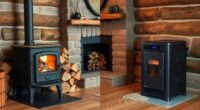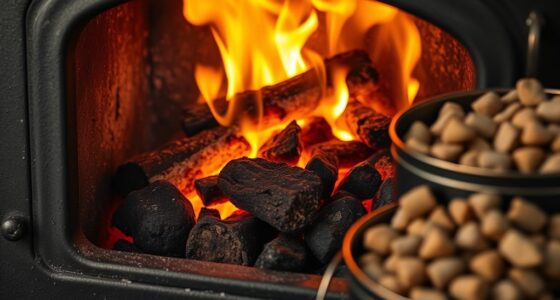The rise of high-efficiency wood stoves reflects advances in technology that boost fuel use and cut emissions. Modern designs feature insulated fireboxes, secondary combustion chambers, and catalytic converters, ensuring cleaner, more sustainable heating. These stoves meet strict EPA standards, emitting fewer pollutants while delivering maximum warmth. If you’re interested in how these innovations work and their impact on the environment, there’s plenty more to explore about smart features and future trends.
Key Takeaways
- Modern high-efficiency wood stoves utilize advanced combustion technologies like secondary chambers and catalytic converters to significantly reduce emissions.
- Regulatory standards such as EPA certifications have driven innovations, making stoves cleaner, more efficient, and environmentally friendly.
- Features like insulated fireboxes, adjustable dampers, and heat exchange systems optimize heat output while minimizing fuel use.
- Sustainable fuel practices, including responsibly sourced wood and pellet technology, support eco-friendly heating solutions.
- Emerging innovations like smart controls and thermoelectric generators are shaping the future of efficient, low-emission wood heating.
The Evolution of Wood Stove Technology
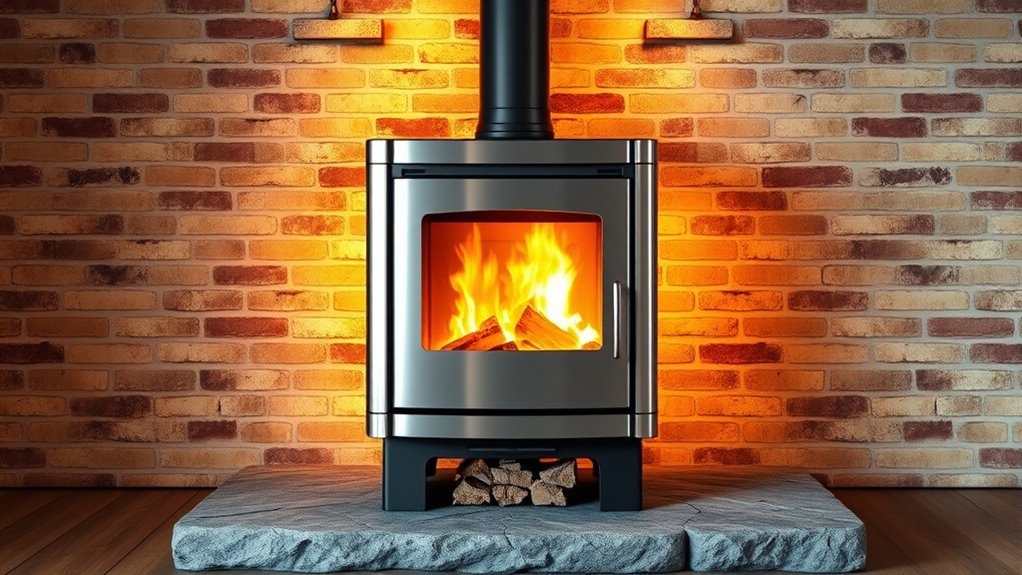
The evolution of wood stove technology has been a continual process of innovation aimed at increasing efficiency and reducing emissions. Early designs, like cast-iron stoves from China around 220 A.D., laid the groundwork. Over centuries, advancements such as secondary combustion improved heat transfer and fuel efficiency. In the late 20th century, EPA-certified stoves incorporated catalytic converters and innovative insulation, markedly lowering emissions and boosting efficiency standards—up to 85%. Modern high-efficiency designs utilize combustion analysis tools to optimize performance. These innovations have made stoves more environmentally friendly, with features like catalytic converters further reducing pollutants. Incorporating advanced combustion techniques has significantly enhanced overall stove performance and reduced environmental impact. Additionally, the integration of efficient stove models ensures that these improvements continue to meet increasing environmental standards and user demands. The implementation of energy-efficient designs also helps in maximizing heat output while minimizing emissions. Today’s developments focus on maximizing heat output while minimizing emissions, ensuring that wood stove technology continues to evolve into cleaner, more efficient heating solutions. For example, the use of airflow management strategies helps improve combustion efficiency and reduce smoke emissions. Furthermore, implementing seasonal efficiency ratings allows consumers to better assess the stove’s performance and environmental impact.
Key Features of Modern High-Efficiency Models
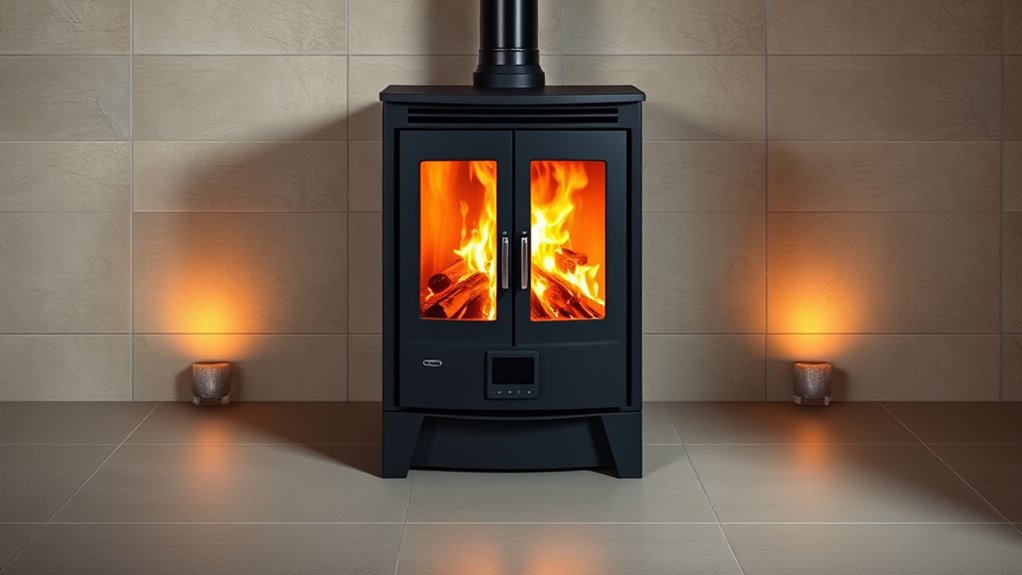
Modern high-efficiency wood stoves pack advanced features that maximize heat output while minimizing emissions. Insulated fireboxes retain heat, improving burn efficiency and ensuring clean combustion. Secondary and tertiary combustion chambers, along with catalytic converters, promote complete burning of wood, reducing smoke and emissions. Precise airflow control through adjustable dampers and large baffles optimizes burn conditions, resulting in hotter, cleaner fires. Heat exchange systems with integrated tubes or channels transfer maximum heat from the combustion chamber to your home, boosting efficiency. Some models incorporate thermoelectric generators (TEGs) that convert excess heat into electricity, powering fans or other components. These features work together to enhance heat transfer, increase burn efficiency, and promote emission reduction, making modern high-efficiency stoves a smart and environmentally conscious choice. Additionally, the role of attention in designing and maintaining these advanced systems ensures optimal performance and longevity of the stove. Proper system maintenance is crucial to sustain efficiency and safety over time. Moreover, innovations in combustion technology continue to improve the effectiveness and sustainability of these heating solutions, ensuring they meet future environmental standards and user demands.
Environmental Benefits and Emission Reductions

Modern EPA-certified wood stoves emit far fewer pollutants, helping improve air quality in your community. Their advanced technology burns fuel more completely, reducing smoke, soot, and harmful gases. By choosing sustainably sourced wood, you support carbon-neutral practices that benefit the environment. Additionally, using high-efficiency models can further enhance combustion and reduce emissions. Incorporating renewable biomass as a fuel source can also contribute to a more sustainable heating solution. Investing in energy-efficient appliances ensures you maximize environmental benefits while reducing your carbon footprint. Implementing emission reduction strategies can further improve air quality and support community health.
Lower Emissions Technology
Advancements in high-efficiency wood stove technology have particularly lowered emissions, helping you reduce air pollution while enjoying renewable heating. Modern EPA-certified models emit as little as 1.3 grams of particulate matter per hour, considerably decreasing harmful pollutants. The integration of catalytic converters and secondary combustion chambers enables nearly complete combustion of gases, reducing emissions by up to 90%. These innovations, like preheated secondary air and optimized airflow, make the stove a clean-burning option that minimizes smoke and soot. Regulatory standards, such as EPA Phase II, have driven these technological improvements, ensuring that your stove operates sustainably. Efficient combustion technologies play a crucial role in achieving these lower emission levels while maintaining heat output. With these lower emissions technologies, you benefit from efficient heating that adheres to strict environmental standards, balancing renewable energy use with a cleaner environment. Additionally, ongoing research in emission reduction continues to improve these systems for even cleaner operation in the future. Moreover, the adoption of automated controls in modern stoves helps optimize combustion efficiency and further reduce emissions by adjusting airflow and burn rates in real-time. Advances in sensor technology are also contributing to smarter control systems that enhance overall performance and emission compliance. Incorporating environmental considerations into design ensures that future stove models will further minimize ecological impact.
Sustainable Fuel Practices
Using sustainably sourced wood, such as fast-growing alder harvested every 3-4 years, helps guarantee your fuel remains renewable and minimizes environmental impact. By choosing a sustainable fuel, you support responsible forest management and reduce the strain on natural resources. High-efficiency wood stoves maximize heat conversion, which aids in emissions reduction. Proper harvesting ensures trees are replanted and forest ecosystems stay healthy. Well-seasoned hardwood with around 20% moisture content burns cleaner, lowering smoke and pollutants. Pellet stoves, utilizing byproducts like sawdust, promote waste-to-energy practices. To maintain an eco-friendly approach, always opt for renewable resources and sustainable fuel practices, ensuring your heating method remains both effective and environmentally responsible. Incorporating sustainable harvesting methods can further enhance the environmental benefits of your heating system. Additionally, choosing certified firewood ensures that your fuel is harvested responsibly and adheres to environmental standards. Ensuring your stove installation adheres to safety standards and regulations is essential for safe operation and environmental protection.
Comparing High-Efficiency Stoves With Traditional Options

High-efficiency wood stoves outperform traditional options in both performance and environmental impact. They achieve up to 85% efficiency, vastly surpassing traditional wood stoves and open fireplaces, which are only about 10% efficient. Modern, EPA-certified models emit less than 2 grams/hour of particulate matter, compared to older models that produce much more pollution. Features like secondary combustion and catalytic converters improve combustion, reduce emissions, and extend burn times. This means you’ll use less fuel and create fewer pollutants. Traditional wood stoves often require frequent reloading and waste heat through the chimney, while high-efficiency models maximize heat output and reduce environmental impact. Additionally, these advanced stoves typically incorporate energy-efficient technologies that further enhance their performance and sustainability. Implementing environmentally conscious design elements can also significantly lower the carbon footprint of your heating system. Moreover, adopting sustainable heating solutions can contribute to long-term energy savings and a reduced overall environmental footprint. Incorporating innovative design features can further optimize energy use and minimize waste.
Factors to Consider When Choosing a High-Efficiency Stove
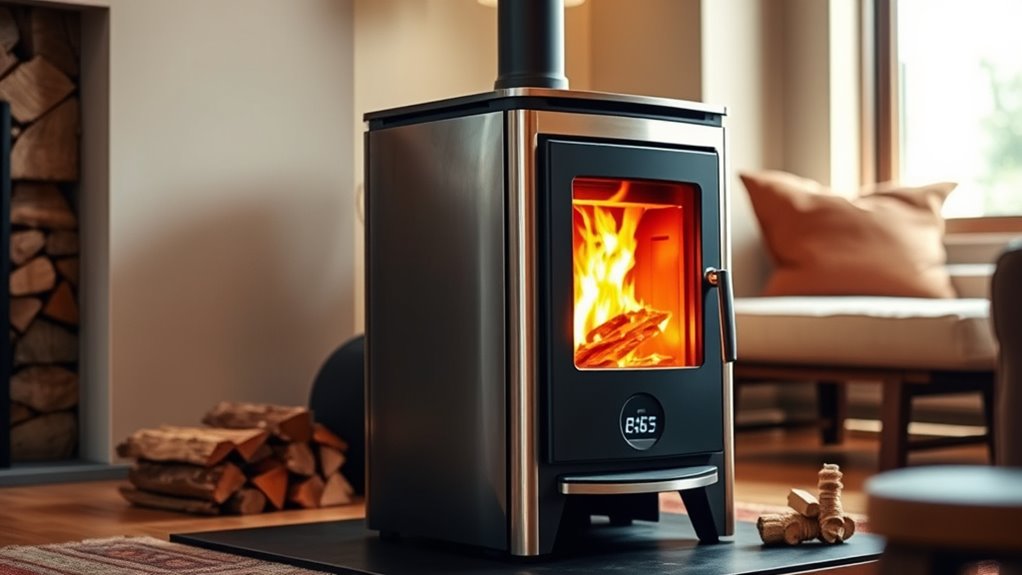
When selecting a high-efficiency wood stove, make certain its size and heating capacity match your home’s needs to avoid wasting fuel or underheating. Check that the stove is EPA-certified to ensure it meets emission standards and operates efficiently. Also, consider features like advanced combustion systems and installation requirements to get the best performance and environmental benefits.
Proper Size and Capacity
Choosing the right stove size is essential to guarantee your home stays warm without wasting fuel. Proper sizing depends on your home’s insulation, size, and climate. An undersized stove won’t provide enough heat, while an oversized one can cause overheating and reduce energy efficiency. When selecting a high-efficiency stove, consider the heat capacity and BTUs needed for your space—stoves rated at 30,000 to 50,000 BTUs typically heat 1,200 to 2,000 square feet. Certified stoves provide detailed heat output specs, helping you match capacity accurately. Consult installer recommendations or online calculators for guidance. Keep in mind:
- Proper sizing ensures ideal heat output
- Firebox size influences heat capacity
- Avoid overheating with the right capacity
- Certified stoves offer reliable data
- Insulation affects your heating needs
Certification and Efficiency
Since certification guarantees a wood stove meets strict emissions standards, it’s a crucial factor in selecting an efficient model, helping you reduce environmental impact and improve indoor air quality. EPA certification ensures your stove complies with emission standards, typically emitting under 4.5 grams of particulate emissions per hour. High-efficiency stoves can reach up to 85% combustion efficiency, thanks to features like catalytic converters, secondary combustion chambers, and insulated fireboxes. These elements boost thermal efficiency and minimize particulate emissions, ensuring cleaner burning. Certified models provide reliable performance, matching the stove’s heat output to your needs while meeting performance standards. Choosing a stove with verified emission ratings and high thermal efficiency helps you maximize fuel economy and reduce air pollution, making it a smart, eco-friendly investment.
Future Trends and Innovations in Wood Heating
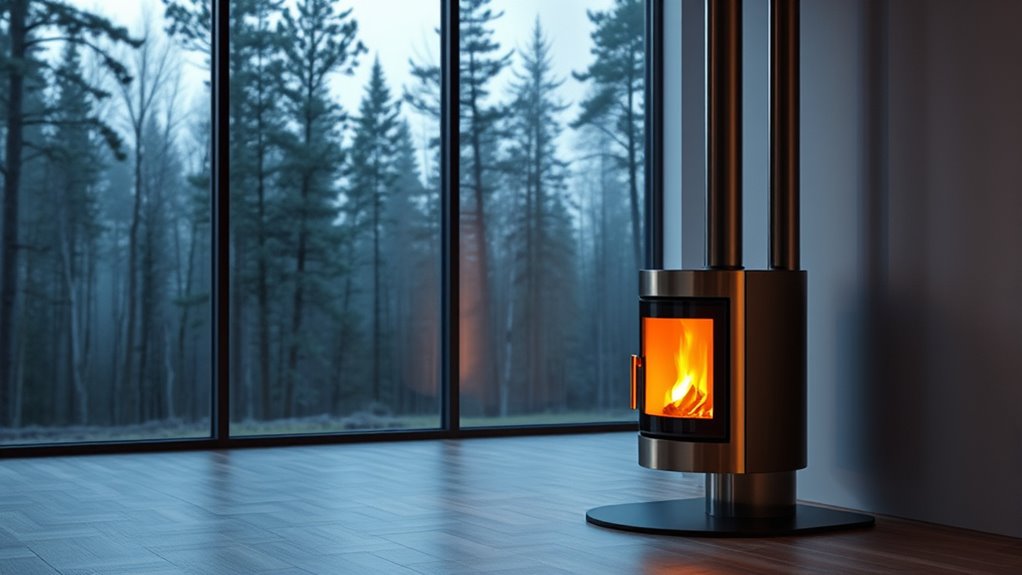
Advancements in wood stove technology are shaping a more efficient and environmentally friendly future for home heating. You can expect high-efficiency wood stoves to incorporate cutting-edge innovations that prioritize emissions reduction and energy recovery. Future trends include seamless smart home integration, allowing real-time performance monitoring and automated control. Technological breakthroughs like thermoelectric generators enable energy recovery, reducing reliance on external power sources. Combustion analysis and gas-flow modeling optimize designs for cleaner, more efficient burning. Governments are investing heavily, such as the DOE’s $3 million fund, fueling rapid development. Stay ahead by watching for these developments:
Emerging wood stove tech boosts efficiency, reduces emissions, and integrates smart features for greener, smarter home heating.
- High-efficiency designs with lower emissions
- Smart home system integration
- Thermoelectric generators for energy recovery
- Advanced combustion analysis techniques
- Ongoing technological breakthroughs
Frequently Asked Questions
Are Newer Wood Stoves More Efficient?
Yes, newer wood stoves are more efficient. You’ll notice they achieve up to 85% efficiency, far surpassing traditional fireplaces. These advanced models use technologies like secondary and tertiary combustion to burn gases completely, reducing emissions. Plus, features like catalytic converters and insulated fireboxes improve heat transfer. When you choose a modern stove, you’re benefiting from better energy use, cleaner emissions, and more effective heating for your home.
What Is the 3:2-10 Rule for Wood Stoves?
Think of the 3:2-10 rule as your guiding compass for safe, efficient fire-making. You start with a small, hot fire—using three parts kindling to two parts small wood—like kindling igniting your journey. Keep the fire at 80-90% capacity, ensuring good airflow, and burn for about 10 hours. Following this balance maximizes heat, reduces pollution, and keeps your stove running smoothly, like a well-tuned engine.
How Does the 26% Tax Credit for a Wood Stove Work?
You can take advantage of the 26% federal tax credit when you purchase a qualifying wood stove. This means you deduct 26% of the stove’s cost from your federal income taxes. To qualify, the stove must meet EPA emission standards and be installed in your main or secondary residence. Keep your receipts and certification documents, and claim the credit when you file your taxes to save money on your upgrade.
Is There a Future for Wood-Burning Stoves?
Imagine your home as a ship steering toward a sustainable future. The current question about the future of wood-burning stoves is essential. You’ll find that advances in technology, strict emissions standards, and policy incentives act like sturdy winds propelling this ship forward. With ongoing innovation and growing interest in energy independence, high-efficiency wood stoves are poised to remain a key, eco-friendly option for your home heating needs.
Conclusion
Embracing a high-efficiency wood stove isn’t just a smart choice—it’s like wielding a powerhouse of eco-friendly warmth that could outshine even the sun on a cold winter day. With advanced technology, you’ll enjoy cleaner emissions, lower energy costs, and cozy comfort for years to come. Don’t settle for outdated heat sources when the future of wood heating is here, ready to transform your home into a haven of sustainability and warmth.


